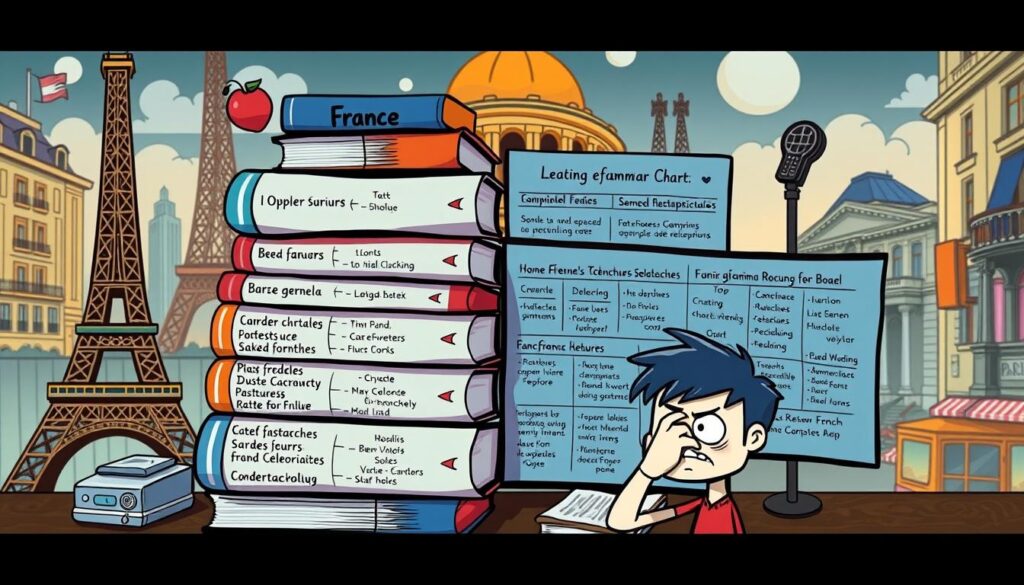With over 100 million downloads, Duolingo French stands out as a popular path for learners seeking to enhance their language proficiency. Touted for its effective, gamified approach to education, Duolingo French proficiency levels are structured to align with the widely recognized Common European Framework of Reference for Languages, setting clear milestones for achieving language mastery.
From the initial ‘Rookie’ stage to the advanced echelons of ‘Navigator’, Duolingo meticulously guides users to a Duolingo French skill level that potentially culminates at a B2 CEFR ranking, symbolizing upper-intermediate expertise or foundational fluency in the French language. Whether your ambition is to order a croissant with poise or to prepare comprehensive reports in French, the course’s level demarcations – from A1 ‘Traveler’ to B2 ‘Navigator’ – pave the way for an enriching linguistic journey.
Cognizant of the hours needed for proficiency, as reported here, Duolingo French fluency is a goal attainable with dedication and sustained effort. Certainly, the love for French can expand beyond Duolingo’s French proficiency level A1/A2, which serves primarily beginners, paving the route for practice and refinement at higher B1/B2 levels through consistent, enjoyable learning experiences on the app.
Understanding the CEFR-Based Proficiency Scale for Duolingo French
The Common European Framework of Reference for Languages (CEFR) outlines the levels of language proficiency ranging from A1, the most basic level, to C2, which indicates near-native fluency. These standardized levels are used to measure and compare language proficiency, not just in French but across various languages. This system is crucial for setting achievable learning goals and understanding language proficiency in a structured manner.
Introduction to CEFR Levels and Their Significance
The CEFR system, developed by the Council of Europe, classifies language skills into three broad categories—Basic User, Independent User, and Proficient User—which are further subdivided into six levels: A1, A2, B1, B2, C1, and C2. This framework is adopted globally, not only in Europe but also in countries like France where it integrates into national educational standards for languages, known as le Cadre européen commun de référence pour les langues (CECR). The significance of the CEFR levels lies in their universal acceptance as a scale for grading an individual’s language proficiency, providing a clear path to learning and mastery, no matter the learner’s original language background.
How Duolingo Courses Align with CEFR Standards
Duolingo French courses are designed to align closely with the CEFR standards. This alignment helps learners achieve measurable milestones in their language proficiency journey. For instance, at the end of the Duolingo Section 3: Traveler (Foundations 2), users typically reach an A1 proficiency, which includes understanding basic phrases and expressions used in everyday situations. Progress through subsequent sections like Trailblazer (Foundations 3) and Discoverer (Intermediate 2) advances a learner to A2 and B1 levels, respectively. By the completion of Navigator (Intermediate 4), users are expected to operate at a B2 proficiency, engaging in more complex conversations and discussions.
Defining Language Proficiency: A1 to C2 Levels Explained
Each CEFR level represents a significant step up in language ability:
- A1 (Breakthrough): Ability to understand and use familiar everyday expressions and very basic phrases.
- A2 (Waystage): Can communicate in simple tasks requiring a direct exchange of information on familiar topics.
- B1 (Threshold): Can understand the main points of clear standard input on familiar matters regularly encountered in work, school, leisure, etc.
- B2 (Vantage): Can interact with a degree of fluency and spontaneity that makes regular interaction with native speakers quite possible without strain.
- C1 (Effective Operational Proficiency): Can produce clear, well-structured, detailed text on complex subjects.
- C2 (Mastery): Can understand with ease virtually everything heard or read.
To delve deeper into the effectiveness of learning platforms like Duolingo in language education, especially in terms of reaching specific CEFR levels, explore this detailed analysis at Language Yard.
Duolingo’s Approach to Building French Language Proficiency
Duolingo’s gamified approach and diverse learning resources have made it an essential platform for millions learning French. By integrating consistent study with Duolingo, learners can enhance their capacity for French language assessment and overall proficiency.
Incorporating Consistent Study Habits for Better Outcomes
To maximize the effectiveness of Duolingo’s French courses, establishing consistent study habits is crucial. Studies reveal that learners who engage regularly with the platform tend to achieve better results compared to those who study sporadically. This consistency leads to higher retention rates and a deeper understanding of the language.
Utilizing Duolingo’s Interactive Platform to Enhance Learning
Duolingo interactive learning makes mastering French enjoyable and engaging. The platform offers a variety of exercises, including vocabulary, grammar, listening, and speaking drills, designed to address comprehensive language skills. This interactive nature ensures students receive immediate feedback, a key component in rapid skill development.
The Importance of Regular Practice and Language Exposure
Regular exposure to the French language is indispensible for anyone serious about proficiency. Engaging in activities such as listening to French podcasts or reading French literature can significantly boost understanding and fluency. For learners pursuing a more structured path, visiting an online French course can offer guided instruction and additional practice materials.
Beyond the confines of Duolingo, platforms such as italki allow learners to connect with native French speakers for more personalized instruction, addressing limitations in speaking practice and cultural insights not extensively covered by Duolingo.
To quantify the progress achievable through Duolingo, here are some key statistics:
| Feature | Benefit | Statistics |
|---|---|---|
| Gamified Learning | Makes study more engaging | Over 100 comprehensive French courses |
| Interactive Exercises | Immediate feedback for improved learning | More than 200,000 learner reports daily |
| Extensive Course Content | Covers all aspects of the language | Equivalent to four university semesters for beginners |
By combining Duolingo interactive learning with resources like native speakers and additional language tools, learners can create a comprehensive learning environment that fosters improved language skills and a more profound connection with the French language.
What Level of French Can You Get with Duolingo
Exploring the efficacy of Duolingo in mastering the French language involves understanding how Duolingo French proficiency tests align with real-world language use. This examination contrasts traditional educational methods with modern digital learning platforms, focusing on the tangible benefits and limitations intrinsic to each approach.
Mapping Duolingo French to Real-World Situations
When evaluating how real-world French proficiency from Duolingo translates into everyday situations, it becomes apparent that Duolingo’s design aligns well with practical usage for travelers and casual learners. For instance, navigating dining, shopping, and basic conversational scenarios in French-speaking regions are areas where Duolingo’s users often excel. However, for intricate tasks like business negotiations or advanced academic discussions, additional resources are required to achieve proficiency. Exploring diverse learning tools, including those mentioned in a detailed guide on self-studying French effectively, can enhance these outcomes substantially.
Tangible Language Milestones on the Duolingo Journey
The pathway through Duolingo’s French courses marks various educational milestones. Starting from elementary phrases and greetings, users progress to tackle more complex grammatical structures and dialogues covering a broad array of topics. Each lesson and section on the platform is designed to cumulatively build upon the previous, reinforcing knowledge while introducing new skills, even as users are engaged through a game-like environment with achievements and rewards.
Comparing Duolingo’s French Proficiency with Traditional Learning
While Duolingo offers real-world French proficiency, the depth of language comprehension and conversational adeptness achieved can differ significantly from that provided through traditional learning environments. Traditional methodologies, with more consistent and direct human interaction, offer nuanced insights into cultural contexts and complex language uses that Duolingo occasionally misses. Below is a comparison of key aspects of learning French through Duolingo versus traditional methods:
| Aspect | Duolingo | Traditional Learning |
|---|---|---|
| Approach | Game-like, self-paced | Structured, teacher-guided |
| Focus | Vocabulary and basic grammar | Comprehensive language skills |
| Interaction | Limited speaking practice | High interaction, feedback |
| Cultural Learning | Minimal | Extensive |
The structure and features of the Duolingo app, including its tiers like Duolingo versus traditional French learning platforms, showcase its utility and limits. While it serves as an excellent preliminary tool, mastering French sufficiently often necessitates supplementary study and exposure, accessible through platforms detailed at Duolingo’s CEFR levels review.
Achieving Fluency: Setting Realistic Expectations with Duolingo
Embarking on the quest for Duolingo French fluency can be a rewarding journey, albeit one that requires clear expectations. An analysis of a multilingual enthusiast’s journey that started four years ago conveys valuable insights. For those aiming to learn French through Duolingo, understanding the difference between conversational skills and true fluency is paramount. While this online language program, with its game-style approach, has fostered basic French proficiency for many learners, it’s essential to recognize that it may not fully equip them with the language’s finer nuances, especially in spoken form. A trip to France may land you in situations where the limitations of your Duolingo-focused learning become apparent, especially when it comes to native-speaker-level articulation and comprehension.
Deciphering the Difference Between Fluency and Conversational Skills
True fluency involves a spectrum of linguistic competencies that extends beyond the Duolingo French proficiency scale. While the app excels at imparting foundational grammar, vocabulary, and reading and writing skills, a learner’s speech won’t necessarily mirror that of a native speaker without further immersion and practice. Field tests of polyglot potentials have shown that, despite strong grounding provided by Duolingo, there’s a palpable difference when it comes to listening comprehension, a gap often widened during real interactions in France.
Capabilities and Limitations of Achieving Fluency with Duolingo
Duolingo can assuredly help learners attain a level of comfort with French that enriches travel experiences and enables basic communication. However, the journey from basic understanding to a nuanced grasp involving subtleties of tone and idiom requires engagement that goes beyond an app’s capabilities. Seeking out French language resources, such as podcasts like Coffee Break French, becomes indispensable for those committed to attaining an advanced level of proficiency.
Supplementing Duolingo with Other French Language Resources
To bridge the proficiency chasm, complementing app-based learning with additional resources is advised. The cultural context offered by immersion, conversation with native speakers, and consumption of French media are crucial. Tools like Babbel, focused on real-life conversations, can be integral to this supplementary regimen, sharpening listening and speaking skills that Duolingo touches only peripherally. Given the broad canvas of around 7,000 world languages, drawing on a diversity of learning experiences is vital for true fluency. A balanced reliance on Duolingo and an array of French language resources can turn the dream of speaking French like a local into an achievable reality.


